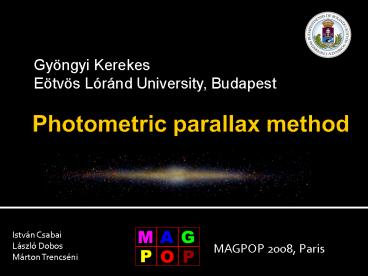Photometric parallax method - PowerPoint PPT Presentation
1 / 15
Title:
Photometric parallax method
Description:
Estimate distances of stars create 3D maps. Explore the ... These libraries were targeted to stars with different stellar parameters. Synthetic magnitudes ... – PowerPoint PPT presentation
Number of Views:140
Avg rating:3.0/5.0
Title: Photometric parallax method
1
Photometric parallax method
- Gyöngyi Kerekes
- Eötvös Lóránd University, Budapest
István Csabai László Dobos Márton Trencséni
MAGPOP 2008, Paris
2
Overview
- Estimate distances of stars ? create 3D maps
- Explore the structure of Milky Way
- Exponencial disks power-law halo(es)
- Dwarf galaxies (merging) and streams
- Our goal reproduce current distributions /
find new structures - Improvements in outer regions, giants
- Gaia (launch around 2011)
3
Estimating parallax and other physical parameters
from colors
QUERY
TRAINING SET
4
Juric et al, 2008
- Polinomial fit to main sequence
- Mrf(r-i)
5
Our estimation method
- Non-parametric estimator
- We use all magnitudes (colors) from SDSS
- Nearest neighbors of a point in a 5D space
- Weight the estimated parameters with an
exponencial distribution - Can be adopted to other photometric systems
6
Training Set
- MILES library
- INDO-US library
- Bright stars from SDSS
- M67
- NGC 2420
- Total number of stars 3392
7
MILES and INDO-US spectra
- These libraries were targeted to stars with
different stellar parameters - Synthetic magnitudes
- Crossmatched with Hipparcos catalog
- Challenges
- wavelength coverage ofspectra is not enough
- normalization of syntheticmagnitudes
8
Bright star catalogs
- No bright stars in SDSS!
- Observations with Photometric Telescope (50 cm)
to calibrate SDSS stars to USNO stars - Crossmatch with Hipparcos ? 117 stars
9
Open clusters from SDSS
- First chosen as test objects
- Turned out at estimation of distances that giants
are overrepresented in the training set - After applying distance modulus from (Harris et
al, 1996) ? we added them to the TS.
Extinction E(B-V) Distance modulus
M67 0.3 9.61 (1)
NGC2420 0.4 12.0 (2)
(1) Anthony-Twarog et al, 2006 (2) An et al,
2007 b.
10
Training set
Mr
r-i
11
Preliminary results
- SDSS Stripe 82 (Image coadd catalog with
improved photometry) - 420,000 stars
12
Preliminary results
- Applying Cartesian coordinate system
13
SDSS Stripe 82 (not coadd)
14
Preliminary results
- Stripe 82 in SDSS (420,000 stars)
15
Future works
- Apply to all SDSS data
- Calculate metallicity
- Combine with kinematics (USNO, RAVE )
- GALEX crossmatch































